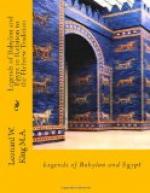(1) In the lecture as
delivered the contents of each column
were necessarily summarized
rather briefly, and conclusions
were given without discussion
of the evidence.
The following headings, under which the six numbered sections may be arranged, indicate the contents of each column and show at a glance the main features of the Sumerian Version:
I. Introduction to the Myth, and account of Creation.
II. The Antediluvian Cities.
III. The Council of the Gods, and Ziusudu’s piety.
IV. The Dream-Warning.
V. The Deluge, the Escape of the Great Boat, and the
Sacrifice to the
Sun-god.
VI. The Propitiation of the Angry Gods, and Ziusudu’s Immortality.
I. INTRODUCTION TO THE MYTH, AND ACCOUNT OF CREATION
The beginning of the text is wanting, and the earliest lines preserved of the First Column open with the closing sentences of a speech, probably by the chief of the four creating deities, who are later on referred to by name. In it there is a reference to a future destruction of mankind, but the context is broken; the lines in question begin:
“As for my human
race, from (or in) its destruction will I
cause it to be (. .
.),
For Nintu my creatures (. . .) will I (. . .).”




